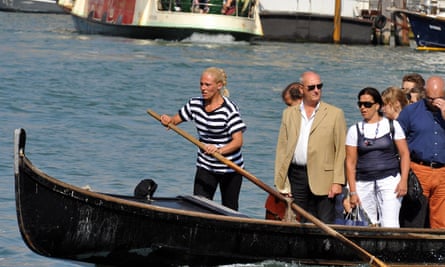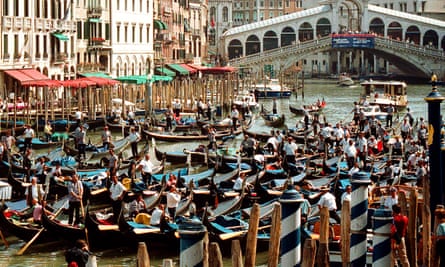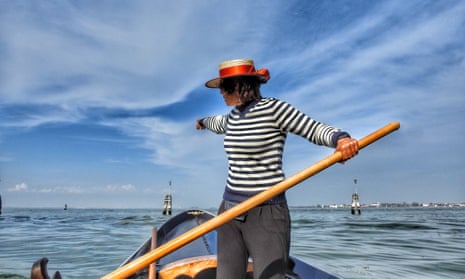For nearly a millennium Venice’s gondoliers were exclusively male. Locked in a tradition of handing down the prestigious role from father to son, it wasn’t until 2010 that 24-year-old Giorgia Boscolo turned the tide in a profession that has been a pillar of the ancient city since 1094.
Boscolo followed in the footsteps of her father, Dante, who had been a gondolier for 40 years. She was granted the coveted licence to guide tourists through the city’s labyrinthine canals after passing a demanding six-month course. In doing so, she became the first officially recognised female gondoliera, finally breaking the mould in a guild that had long resisted women.
After news of her job spread across Italy, a flurry of applications from other women were expected to follow. Except that didn’t happen. “We don’t get women enrolling,” says Aldo Reato, the president of Venice’s gondoliers’ association. “You’d have to ask them why … there have been some others who have tried, but failed the exam. Plenty of women do take part in regattas, but for many it’s not so easy to train to become a gondolier, especially if they have small children to look after.”
The issue of gender in Venice’s centuries-old gondolier community made headlines again last week when a canal rower came out as transgender, once more bringing this city’s unique transport history into the spotlight.

Alex Hai made the announcement on Facebook and in an interview on the American radio show and podcast Radiolab. Hai had taken the gondoliers’ test four times as a woman but failed each time, saying that examiners were “overly strict” and accusing the 425-strong association of deliberately keeping him out because of his sex at the time. The association has strongly refuted this claim, and in 2015 Hai won a court battle to privately operate as a gondolier for a hotel chain owned by a local aristocrat.

Reato says it’s not easy for anyone to pass the gondolier exam, regardless of their gender. “It’s a very technical job and involves lots of different skills, like watching for weather patterns,” he says. Navigation is key, as is a basic knowledge of English and a good understanding of the city’s landmarks. Each year there are just 40 places on the gondolier course, which includes 400 hours of instruction in the use of the single oar used to propel the gondola through the canals.
To this day, Boscolo remains the only woman allowed to officially operate a gondola. The ancient 35ft, 6in vessel was the main form of transport in Venice for centuries, ferrying the lower echelons of society around before being embraced by aristocrats when their preferred mode of transport – horses – were banned from the city’s narrow streets in the 14th century. By the 16th century, an estimated 10,000 gondolas were being rowed around Venice. Today there are only 425.
Just one other woman shares the Venetian waterways with Boscolo, but in a different craft. Chiara Curto, originally from Genoa, turned a passion for rowing into a job when she passed exams last year to row a flat-bottomed boat known as a sandolo – or punt – of which there are around 40 that operate for tourists alongside gondolas.

Requirements for piloting the sandolo are as stringent as for a gondola, with Curto being granted a licence after a similar six-month training process. “It is a tough process and a physically tiring job … there aren’t that many women who want to do it,” she says. She added that she had never experienced any sexism in the trade, saying: “My colleagues have been welcoming and supportive.”
But whoever is steering these ancient vessels, there is a clear solidarity when it comes to keeping the centuries-old tradition intact. When Venice introduced a public motorised water bus service in the 1880s, gondoliers held their first strike. That activism is still prevalent today, and gondoliers often protest against water taxis and speedboats, arguing that their reckless driving risks lives as they whip up waves that rock the smaller vessels. In 2013, a German tourist was killed when a water bus crashed into the gondola he was riding in with his family on the Grand Canal.
“Ironically, the [gondolier] service has been maintained through the growth of tourism, and gondoliers have become unlikely champions of an ongoing war against the corrosive effects of big waves produced by motorboats, including the public water bus service,” says Dominic Standish, a British professor of sociology based in Italy. “Inevitably, they are representative of Venice’s ancient traditions against the march of modern motorised water boats.”
Realto is adamant that he wishes more women would come on board. “Women do everything these days … they go to space, they fight in wars, so why not?”

Comments (…)
Sign in or create your Guardian account to join the discussion